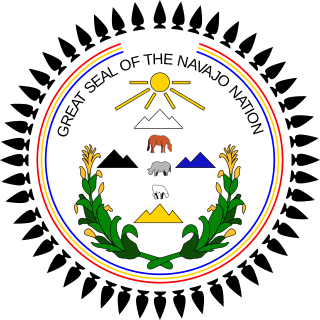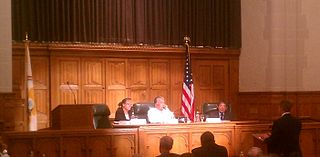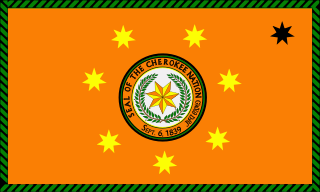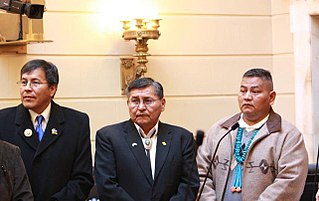
Window Rock, known in Navajo as Tségháhoodzání, is a city and census-designated place that serves as the capital of the Navajo Nation, the largest Native American tribe by both land and tribal enrollment. The capital lies within the boundaries of the St. Michaels Chapter, adjacent to the Arizona and New Mexico state line. Window Rock is the site of the Navajo Nation governmental campus, which contains the Navajo Nation Council, Navajo Nation Supreme Court, the offices of the Navajo Nation President and Vice President, and many Navajo government buildings.

Dilkon is a census-designated place (CDP) in Navajo County, Arizona, United States. The population was 1,184 at the 2010 census. The name of the town is said to be derived from the Navajo phrase "Smooth black rock" or "Bare surface.”

The Navajo Nation, also known as Navajoland, is an Indian reservation of Navajo people in the United States. It occupies portions of northeastern Arizona, northwestern New Mexico, and southeastern Utah. The seat of government is located in Window Rock, Arizona.

Tribal sovereignty in the United States is the concept of the inherent authority of Indigenous tribes to govern themselves within the borders of the United States.

The Navajo Nation Council is the Legislative Branch of the Navajo Nation government. The council meets four times per year, with additional special sessions, at the Navajo Nation Council Chamber, which is in Window Rock, Arizona.

The Supreme Court of the Navajo Nation is the highest judicial Native American authority of the Navajo Nation, the largest American Indian nation in the United States. According to Harvard Law School, "the judicial system of the Navajo Nation is the most active tribal judicial system in the United States, with a case load that rivals, and in some instances exceeds, many municipal, county, and state judicial systems."

A tribal chief, chieftain, or headman is the leader of a tribal society or chiefdom.

The Cherokee Nation, formerly known as the Cherokee Nation of Oklahoma, is the largest of three federally recognized tribes of Cherokees in the United States. It includes people descended from members of the Old Cherokee Nation who relocated, due to increasing pressure, from the Southeast to Indian Territory and Cherokees who were forced to relocate on the Trail of Tears. The tribe also includes descendants of Cherokee Freedmen and Natchez Nation. As of 2024, over 466,000 people were enrolled in the Cherokee Nation.
In Canada, an Indian band, First Nation band or simply band, is the basic unit of government for those peoples subject to the Indian Act. Bands are typically small groups of people: the largest in the country, the Six Nations of the Grand River First Nation had 22,294 members in September 2005, and many have a membership below 100 people. Each First Nation is typically represented by a band council chaired by an elected chief, and sometimes also a hereditary chief. As of 2013, there were 614 bands in Canada. Membership in a band is controlled in one of two ways: for most bands, membership is obtained by becoming listed on the Indian Register maintained by the government. As of 2013, there were 253 First Nations which had their own membership criteria, so that not all status Indians are members of a band.

The Ramah Navajo Indian Reservation is a non-contiguous section of the Navajo Nation lying in parts of west-central Cibola and southern McKinley counties in New Mexico, United States, just east and southeast of the Zuni Indian Reservation. It has a land area of 230.675 sq mi (597.445 km2), over 95 percent of which is designated as off-reservation trust land. According to the 2000 census, the resident population is 2,167 persons. The Ramah Reservation's land area is less than one percent of the Navajo Nation's total area.

Kenneth Maryboy is an American politician for San Juan County, Utah, and was Navajo Nation Council Delegate. Kenneth is a former San Juan County Commissioner. Maryboy was the third Democrat in a row to have been elected to the Commissioner District 3 position since its inception in 1984 that divided the county into three districts. Kenneth was replaced on the commission in 2015 by Rebecca M. Benally
Lawrence T. Morgan is the former Speaker of the Navajo Nation Tribal Council.

Davis Filfred is an American politician for the Navajo Nation Council Delegate in the Utah Navajo Section.

Henry Chee Dodge, also known in Navajo by his nicknames Hastiin Adiitsʼaʼii and Kiiłchííʼ, was the last official Head Chief of the Navajo Tribe from 1884 until 1910, the first Tribal Chairman of the Navajo Business Council from 1922 until 1928, and chairman of the then Navajo Tribal Council from 1942 until 1946. He was the father of Thomas Dodge, who served as Tribal Council chairman from 1932 until 1936, and activist Annie Dodge Wauneka.
The Project on Indigenous Governance and Development, previously named the Harvard Project on American Indian Economic Development, also known as the Harvard Project, was founded in 1987 at Harvard Kennedy School at Harvard University. It administers tribal awards programs as well as provides support for students and conducting research. The Harvard Project aims to understand and foster the conditions under which sustained, self-determined social and economic development is achieved among American Indian nations through applied research and service.

Ben Shelly was the 7th president of the Navajo Nation. He was the first president to have been elected both president and vice president of the Navajo Nation, as well as the first New Mexican Navajo to hold the Navajo presidency.
Kerr-McGee v. Navajo Tribe, 471 U.S. 195 (1985), was a case in which the Supreme Court of the United States held that an Indian tribe is not required to obtain the approval of the Secretary of the Interior in order to impose taxes on non-tribal persons or entities doing business on a reservation.
Salazar v. Ramah Navajo Chapter, 567 U.S. 182 (2012), was a United States Supreme Court case in which the Court held that the United States government, when it enters into a contract with a Native American Indian tribe for services, must pay contracts in full, even if Congress has not appropriated enough money to pay all tribal contractors. The case was litigated over a period of 22 years, beginning in 1990, until it was decided in 2012.

Lesbian, gay, bisexual, and transgender (LGBT) people in the Navajo Nation, the largest indigenous sovereign state in the United States, face legal challenges not experienced by non-LGBT residents. Same-sex sexual activity is legal, but same-sex unions are not recognized, and marriage has been banned by the tribal constitution since 2005. In 2022, a bill was introduced to repeal the ban and recognize same-sex marriage, but has faced challenges on the reservation.
The 1989 Navajo Nation Council Reforms, also known as the Title II Amendments were a series of Constitutional changes to the government structure of the Navajo Nation. Following 1985 reforms to the Judicial Branch, the reforms were meant to separate the powers of the Tribal Council the President and the Supreme Court with a checks and balances system similar to that of the U.S. Constitution. The resolutions were adopted by the Council on December 15, 1989 and became law on April 11, 1990.















